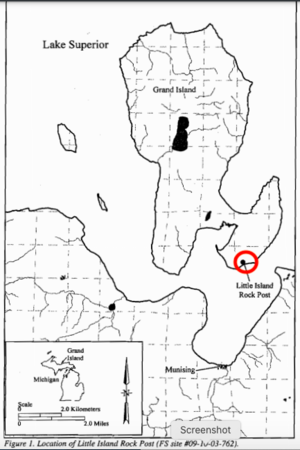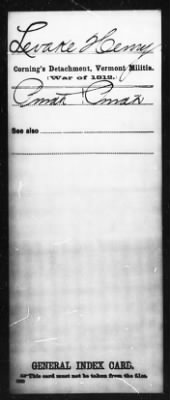Biography
Henry was born about 1793. He served in the War of 1812 as a Private in Corning’s Detachment of the Vermont Militia (4th Vermont Regiment). He participated in the Battle of Plattsburgh. [1]
Henry, came to Michigan armed with a Fur Trader’s license. He opened a trading post on Grand Island in Lake Superior near present day Munising, and took up with an Ojibwe woman who bore him one child, Mary. Henry later became a legislator in Detroit for the newly formed territory of Michigan and later, the newly made state of Michigan. He died sometime in late 1839 or early 1840, after having acted as interpreter for Lewis Cass in LaPointe, Wisconsin.
Mary came to Sault Ste. Marie with her mother, Therese Relle, who married Joseph McLeod. He signed up with the Huron Outfit of the Hudson’s Bay Company, stationed near Manitoulin Island in Ontario. Here Mary met Louis Bareilles dit Lajoie, who was also a Hudson’s Bay employee. They married in 1837. After Louis retired from the HBC service they came to St. Ignace, Michigan. [2]
The following is an excerpt from Wintering at Little Island Rock: A Fur Trade Site on Grand Island John G. Franzen, Published 2004, Midcontinental Journal of Archaeology:
The Hiawatha National Forest personnel in 2000–2002 investigated the well-preserved archaeological remains of a circa 1820s fur trader’s wintering post located on Grand Island, near the south shore of Lake Superior. The most likely occupant of this post was Henry A. Levake, a trader from Sault Sainte Marie (St. Mary’s Falls) who was accompanied by his Native American wife. Both archaeological and historical information show that the Little Island Rock Post is an example of a specialized cold-climate adaptation developed in the boreal forests of North America and in the northern portion of the temperate forests to the south. Key elements of this adaptation include: location near a late fall or winter fishery, use of large amounts of clay for chimney construction, and the presence of ample storage facilities, especially pits. Features associated with this adaptation at the Little Island Rock Post also reflect the multiethnic occupational subculture of the fur trade. This site fills a large gap in the known distribution of wintering post archaeological sites across North America.
The earliest references that relate to the Little Island Rock Post are found in accounts prepared by members of the 1840 Houghton expedition. It mentions an “old trade post” on the southeast portion of Grand Island with mention of only one trader in this narrative; “It was on this Island that Mr. Levake had a trading post for a number of years, some 12 years since.” A newspaper article based on conversations with Bay Mills elder Charles Marshall, whose family once lived on Grand Island, mentions a Chippewas village there called “Little Island Rock” and a nearby trading post operated by an “Eastern Frenchman” named Henry LeVesque and his Native American wife. Henry Levake is listed in the 1820 census for Michilimackinac County, Michigan Territory, as “engaged in commerce”.
Henry Levake is listed as a witness in several Indian treaties, which also included benefits for “Fanny Levake, daughter of Meeshwaqua” and her children.The Little Island Rock trading site was occupied during a period when the British in Canada were still considered a serious economic and military threat to American activities in northern Michigan.
Sources
- ↑ History of Bolton by Gardiner Lane, page 7 & 8
- ↑ Hammond, Cleon E., Augustus Levake, 1757-1822, Biographical Sketch and Partial Genealogy of His Descendents. Schooley's Mountain, New Jersey, 07870. 06 June 1986.
- Hammond, Cleon E., Augustus Levake, 1757-1822, Biographical Sketch and Partial Genealogy of His Descendents. Schooley's Mountain, New Jersey, 07870. 06 June 1986. No ISBN, private printing?
- Wikipedia Profile
- United States War of 1812 Index to Service Records, 1812-1815, database with images, FamilySearch (https://familysearch.org/ark:/61903/1:1:Q29K-6B7L : 8 March 2021), Henry Levake, 1812-1815; citing NARA microfilm publication M602 (Washington, D.C.: National Archives and Records Administration, n.d.); roll 125; FHL microfilm 882,643.
- "United States Census, 1800," database with images, FamilySearch (https://familysearch.org/ark:/61903/3:1:33S7-9RZ6-L8X?cc=1804228&wc=3V1X-8PF%3A1585149303%2C1585149667%2C1585148510 : 10 June 2015), Vermont > Chittenden > Bolton > image 1 of 2; citing NARA microfilm publication M32, (Washington D.C.: National Archives and Records Administration, n.d.).
- "United States Census, 1820," database with images, FamilySearch (https://familysearch.org/ark:/61903/1:1:XHLP-XKY : accessed 16 October 2021), Henry A Levake, Michilimackinac, Michigan, United States; citing p. , NARA microfilm publication M33, (Washington D.C.: National Archives and Records Administration, n.d.), roll 56; FHL microfilm 506,762.
- Treaty Between the United States and the Chippewa Indians Signed at Fond du Lac of Lake Superior, Michigan Territory
- Wintering at Little Island Rock: A Fur Trade Site on Grand Island John G. Franzen, Published 2004, Midcontinental Journal of Archaeology
- Collections of the State Historical Society of Wisconsin By State Historical Society of Wisconsin, page 289
It may be possible to confirm family relationships. It is likely that these autosomal DNA test-takers will share some percentage of DNA with Henry:
-
~1.56%
 ~1.56%
Terry Weller
~1.56%
Terry Weller  :
AncestryDNA, GEDmatch A793610 [compare], Ancestry member trashound51
:
AncestryDNA, GEDmatch A793610 [compare], Ancestry member trashound51
-
~0.78%
G. Ouellet
 :
AncestryDNA
:
AncestryDNA
Featured Eurovision connections: Henry is 31 degrees from Agnetha Fältskog, 22 degrees from Anni-Frid Synni Reuß, 26 degrees from Corry Brokken, 11 degrees from Céline Dion, 24 degrees from Françoise Dorin, 26 degrees from France Gall, 27 degrees from Lulu Kennedy-Cairns, 27 degrees from Lill-Babs Svensson, 21 degrees from Olivia Newton-John, 32 degrees from Henriette Nanette Paërl, 31 degrees from Annie Schmidt and 17 degrees from Moira Kennedy on our single family tree. Login to see how you relate to 33 million family members.
L > Levesque | L > Levake > Henry Adolphus (Levesque) Levake
Categories: Hudson's Bay Company | War of 1812 | Battle of Plattsburgh



